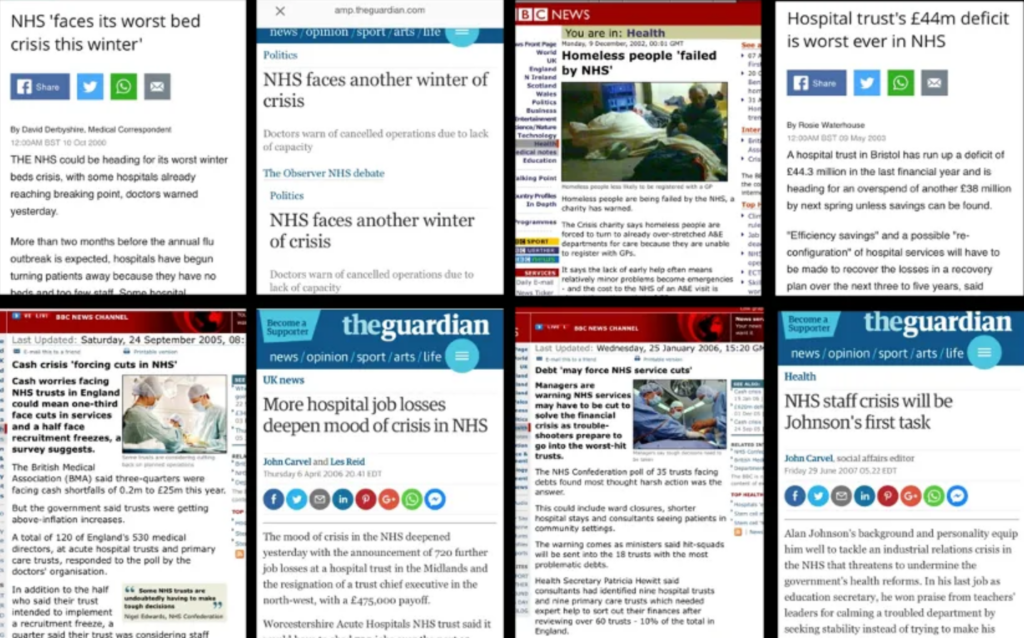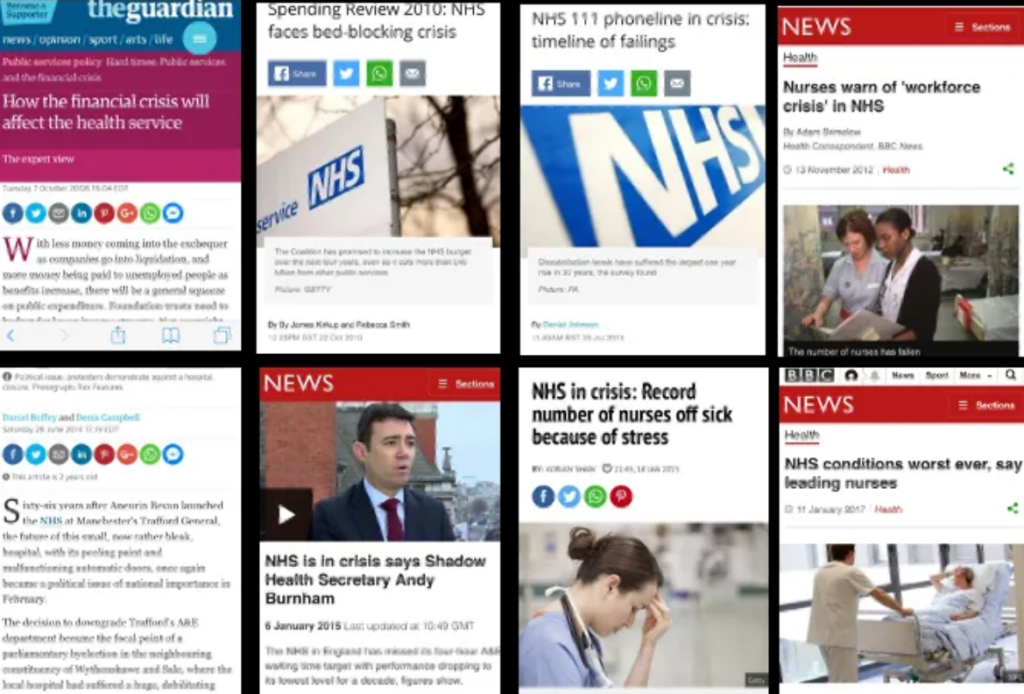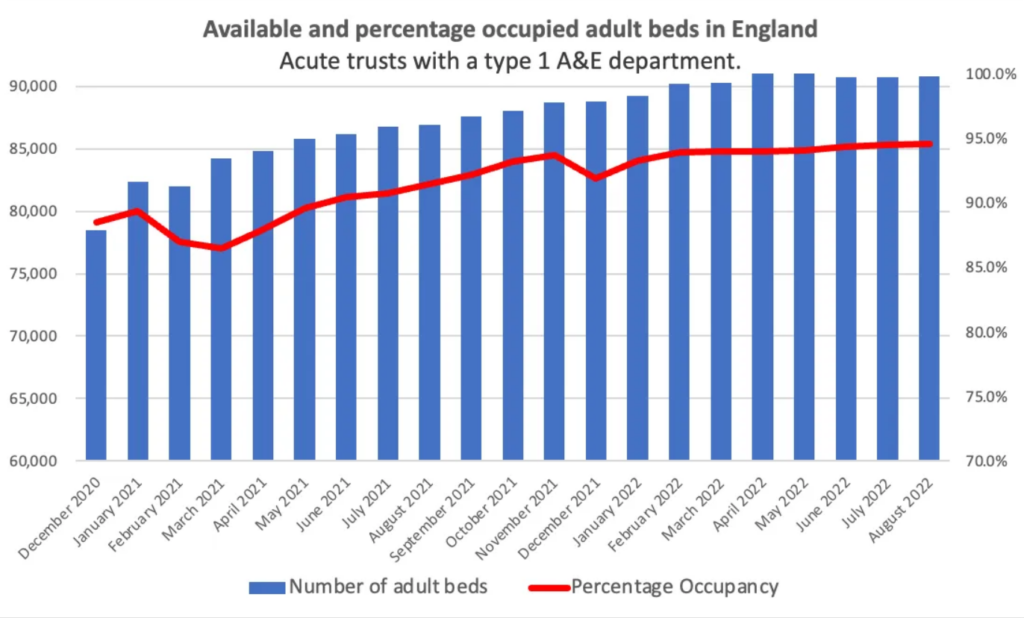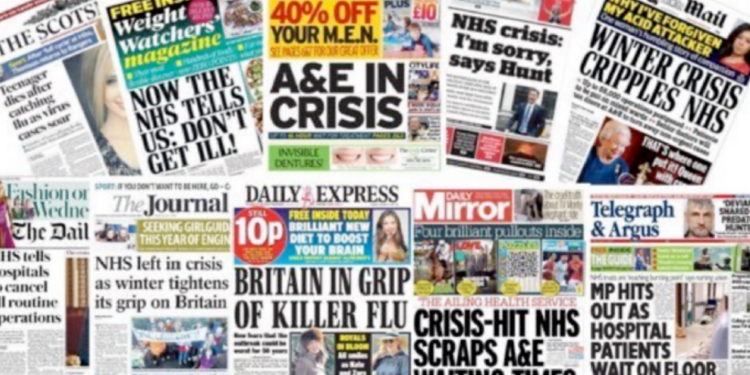The question on everyone’s tongue right now is will the NHS be in crisis this winter? The headlines say it all: NHS faces its worst bed crisis this winter; NHS faces another winter of crisis, and homeless people failed by the NHS.
Do you recognise these headlines? You probably do, but did you realise that they date from 2000, 2001 and 2002?

If you have a good memory, you see that virtually every year there is a problem with either the ‘cash’, the mood, the debt or the crises within the workforce (or all of them together).
In 2005 the Labour Party promised sustained investment to reduce waiting times, expand the NHS workforce and improve buildings and facilities. Specifically, it pledged to triple spending. As a result, spending increased from £33.5 billion in 1997-98 to £76.4 billion in 2005-06.
So what happened? More of the same: bed-blocking, phone lines in crisis and record numbers off sick.

Through the pandemic, the situation has substantially worsened. The lack of critical capacity saw hundreds of millions wasted on Nightingale hospitals while access and waiting times worsened.
The situation on the ground is dire: patients die while waiting in the emergency department. Apparently, conditions are so bad that “staff are quitting for pubs and shops instead”.
Currently, NHS England data show there’s an average of 90,500 available beds in those hospitals with an emergency department – roughly two beds available per 1,000 adults – one of the lowest figures in Europe. Contrast this with Germany, which has eight beds per 1,000 – many low-tech and embedded in the community.

However, everything will be okay. The Health Secretary Thérèse Coffey has a ‘laser-like’ focus on the NHS problems – sounds familiar.
The plans involve increasing 999 call handlers, 7,000 extra hospital beds will appear this winter and there will be £500m for a social care discharge fund and a £15m overseas recruitment fund.
Historical admission data show that, on average, 30,000 respiratory admissions occurred in December, roughly double the number for August. Yet, occupancy is already running at about 95%. So there are about 5,000 available beds to deal with roughly 15,000 extra admissions. We assume the shortfall will be plugged by the extra 7,000 beds. Where these beds will come from and who will staff them is unclear. However, the message for the Minister is clear: there isn’t much slack in the system.
The problem is complex and long-lasting – short-term fixes won’t suffice. The massive increases in spending since the Tony Blair years have not fixed the winter NHS woes. Health Secretaries come and go – they don’t last long in their job; in the last 20 years, 10 have been in post and moved on. All have had plans to deal with the winter crises – so far, all have failed.
So, what would you forecast for this coming winter if you were a betting person?
Dr. Carl Heneghan is the Oxford Professor of Evidence Based Medicine and Dr. Tom Jefferson is an epidemiologist based in Rome who works with Professor Heneghan on the Cochrane Collaboration. This article was first published on their Substack page, which you can subscribe to here.













To join in with the discussion please make a donation to The Daily Sceptic.
Profanity and abuse will be removed and may lead to a permanent ban.
Nothing will ever change without totally dismantling the health system as it stands, and I can’t see anyone getting to grips with that anytime soon. It doesn’t help that the NHS is seen as some kind of sacred cow that most people praise rather than criticise, despite the evidence in front of their eyes. I am willing to bet 50 to 60% of the management jobs, which often appear to duplicate each other, could be got rid of.
This coming winter…covid, blah blah blah, flu, blah blah blah – and of course it will all the the fault of the general public because they are thoughless enough to catch things, get sick and clutter up the wards. The NHS often has the knack of making you feel you are a nuisance, doesn’t it?
Cleansing the structural Blairism might already help.
Every problem that has afflicted this country since Bliar was encouraged to quit can be attributed to –
Tony Bliar.
That horrible, evil piece of crap will still be undermining this country even when he has been called to Satan’s side.
An interesting question would be how much direct influence he possibly still wields. Eg, both NHS management and the Tony Blair Institute favour the same policy decisions wrt the so-called pandemic. Is this really coincidence or is someone exploiting still existing person networks there?
Poor Satan.
…and Starmer now ‘channeling’ his inner Tony Blair, gawd help us.
Couldn’t agree with you more.
Doubtless there will be an outbreak of mask-enforcement and social distancing at hospitals this month. This will have two effects. First, it will increase the illusion that the NHS is battling with an unprecedented and overwhelming rise in Covid cases, thus diverting attention from the more fundamental long-term and systemic problems that the NHS faces. Secondly, it will provide renewed employment to the mask-bouncers at hospitals and to the installers of sticky-backed arrows and Perspex screens.
PS: it’s Thursday tomorrow; do we bangs saucepans, deploy rainbows or kneel?
Actually, I will be out with my neighbours tonight – not banging pans, just standing around chatting over a bottle or 2 of wine. Every cloud has a silver lining.
For as long as the NHS spends as much as £1 on general political agendas (eg, workforce diversity training instead of medical training), it’s obviously overfunded and throwing more money at it won’t improve anything.
I’ve just been for an x-ray at my local hospital this afternoon and I was not looking forward to it. I was expecting some meeter and greeter with mask and hand sanitiser, but there was none. So I walked in without a mask went to reception booked in. I was taken for an x-ray 10 minutes later and sent on my way without a glance or a word from any member of staff of whom there seemed to be plenty about. A strange experience.
Wow! How lovely! My last encounter with the NHS was in August. Two out of three chairs taped off, plastic screens everywhere & the demand to wear a mask from the reception staff. The HCA who did the pre consultant baselines of height, weight & bp was more than happy to take off hers as was the consultant! He even did a bare hands examination of muscle tone & reflexes.
It’s definitely coming from the top of each Trust. Sadly the compliance amongst the general population attending was high.
Lucky guy. My last few encounters with NHS (dentist and GP) have been very confrontational. Exhausting tbh. Seems to vary wildly though – and that just supports the fact that none of them know what the hell they’re doing or why.
I think you are just being unlucky. Neither my gp surgery nor my dentist (not NHS though) requires masks, and hasn’t done for many months. I think it’s just down to regional variation.
I made an appointment with my GP yesterday (I know what’s wrong and need a prescription-only cream) and the nearest time-slot available is 4 weeks away. And that’s in a small west country town, goodness only knows how long it would be if I lived in an overcrowded city.
From October last year. It’s the annual bleatings for more money etcetera.
As in education, too little money and capacity are not the problem, too much of it certainly is.
Instead, the real problems are attitude, ever worsening work ethics and commitment, internal politics and vested interests leading to now cemented misorganisation and mismanagement.
As with many departments, short term political appointments are subject to manipulation by established professional “servants” which are, in fact “complex and long lasting”. They tend to last long in their jobs, with a nice pension later on.
“The question on everyone’s tongue right now is will the NHS be in crisis this winter?”
Well, let me beg to differ – it’s certainly not a question on my tongue and the subject never entered my head. The opening statement is pure propoganda. Boll Ox.
Actually, the question on my tongue is; are we all going to be nuked into oblivion?
Putting rouge on the cheeks of a corpse. Again.
It is a State run industry. All State run industries fail – fact, backed by multiple examples in multiple Countries over the last Century – and they fail for precisely the same reason, they are State run, therefore they must primarily serve political objectives, secondly serve the interests of the unionised workers who are paid on length of service or grade rather than merit or industry – no incentive to work better/harder.
They cannot go bankrupt and have no shareholders therefore require no fiscal discipline and have no access to private capital. They are cost centres, so there us a perverse incentive to do less to keep within budget. They have no cost/price structure so efficiency/productivity cannot be measured,
There is no competition so consumers have no choice, Leviathan has no need to improve or serve consumer interests.
This will not, can not be changed until the monopoly is taken away and a competitive private market in health insurance and provision can develop.
Absolutely right on every point. Very well said.
Everyone says the NHS is much loved with its free at point of use, but it’s also almost unique in the world in the way it is funded and centrally managed.
Most European systems are to a certain extent ‘private’ in that they’re not managed by central government.
The question is, can a government in the UK change to the European model without too much push back from all the vested interests? Probably not, but one of them really needs to try as the current system of just increasing the money put in is clearly not working.
The other feature that is often not well understood is that some specialists in various roles are available to work for third party private firms, or for themselves, part time. Often in non-NHS buildings just next door, or even in the same building in smaller outfits, such as dental surgeries.
This is relatively unusual in other industries – after all, many contracts do not permit one to work for competitors while employed by a particular firm, for good reasons in most situations.
I am sure face masks worn all day by staff make them feel so much happier and securer in their jobs and the reintroduction of social distancing and other Covid protocols should leave all staff with so much more time for the latest diversity course.